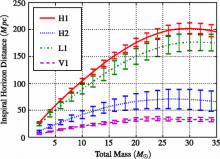
Abstract
We report the results of the first search for gravitational waves from compact binary coalescence using data from the Laser Interferometer Gravitational-Wave Observatory and Virgo detectors. Five months of data were collected during the Laser Interferometer Gravitational-Wave Observatory’s S5 and Virgo’s VSR1 science runs. The search focused on signals from binary mergers with a total mass between 2 and 35M⊙. No gravitational waves are identified. The cumulative 90%-confidence upper limits on the rate of compact binary coalescence are calculated for nonspinning binary neutron stars, black hole-neutron star systems, and binary black holes to be 8.7×10-3 yr-1 L10-1, 2.2×10-3 yr-1 L10-1, and 4.4×10-4 yr-1 L10-1, respectively, where L10 is 1010 times the blue solar luminosity. These upper limits are compared with astrophysical expectations.